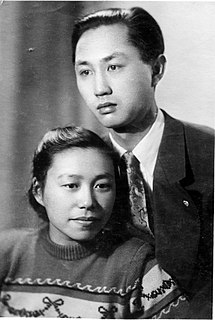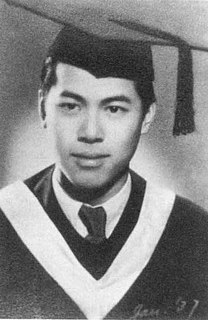
The Shenyang J-5 is a Chinese-built single-seat jet interceptor and fighter aircraft derived from the Soviet Mikoyan-Gurevich MiG-17. The J-5 was exported as the F-5 and was originally designated Dongfeng-101 and also Type 56 before being designated J-5 in 1964.

The Chengdu J-10 Vigorous Dragon, is a medium-weight, single-engine, multirole combat aircraft capable of all-weather operations, configured with a delta wing and canard design, with fly-by-wire flight controls, and produced by the Chengdu Aircraft Corporation (CAC) for the People's Liberation Army Air Force (PLAAF), Pakistan Air Force (PAF) and People's Liberation Army Naval Air Force (PLANAF). The J-10 is mainly designed for air-to-air combat, but can also perform strike missions.

The 1st Fighter Aviation Division is the first aviation division created by the People's Liberation Army Air Force in the 19 June 1950. In the Korean War and the defense of the airspace of the People's Republic of China the division shot down 92 airplanes. It was the first in People's Liberation Army Air Force history to fight in air combat, provide close-air-support, perform night bombing operations and more. It is also the only air division of the People's Liberation Army Air Force to participate in five Chinese national day parades( 1st, 10th, 35th, 50th and 60th national day parades). Headquartered in Xianyang, the division is split into three sub units: first, second and third regiments. Both first and third regiments are stationed in Anshan while the second is stationed in Chifeng.
The Shenyang J-13 was a long-running Chinese project by Shenyang Aircraft Corporation to develop a light-weight, single engine fighter aircraft, that was ultimately cancelled.

The Shenyang J-15, also known as Flying Shark (Chinese: 飞鲨; pinyin: Fēishā; NATO reporting name: Flanker-X2, is a Chinese all-weather, twinjet, carrier-based fourth-generation multirole fighter aircraft developed by the Shenyang Aircraft Corporation and the 601 Institute, specifically for the People's Liberation Army Naval Air Force to serve on People's Liberation Army Navy's aircraft carriers.
The 12th Fighter Aviation Division (第12歼击机师) was an air division of the Chinese People's Liberation Army Air Force (PLA-AF). It was established in 1950, and disestablished by 2016-18.

The Shenyang FC-31Gyrfalcon, also known as the J-31 is a Chinese prototype mid-sized twinjet 5th-generation fighter aircraft developed by Shenyang Aircraft Corporation (SAC). The official nickname published by SAC is "Gyrfalcon", though it has also been referred to as the "F-60" or "J-21 Snowy Owl" in some media reports, or "Falcon Hawk" by some military enthusiasts. J-XX nomenclatures in the Chinese military are reserved for programs launched and financed by the People's Liberation Army, while the FC-31 plane was developed independently as a private venture by the aircraft manufacturer.
The 2nd Fighter Division of the People's Liberation Army Air Force is an air formation of the People's Republic of China. It was part of the Guangzhou Military Region Air Force.

Ye Zhengda was a Chinese aircraft designer and lieutenant general of the People's Liberation Army Air Force. He was also an adjunct professor and senior engineer at Northwestern Polytechnical University. He was a member of the 10th National Congress of the Chinese Communist Party and a delegate to the 5th National People's Congress.
Li Tian was a Chinese physicist and aircraft designer. An expert in aerodynamics for aeronautics, he served as chief scientist of the Shenyang Aircraft Corporation. He was also an adjunct professor at Beihang University.
Nanchang Qingyunpu Airport, also known as Sanjiadian Airport, is an airport in Qingyunpu District of Nanchang, Jiangxi, China. Originally constructed for use by the Republic of China Air Force, it was the largest airport in China when opened in 1935. The airport was destroyed during the Second Sino-Japanese War and rebuilt afterwards. After 1949, it was mainly used for test flights by the aircraft manufacturer Hongdu Aviation Industry Group, until its replacement by Nanchang Yaohu Airport in 2018.
Guan De was a Chinese aeroelasticity engineer and aircraft designer. He participated in the design and development of the Shenyang JJ-1 jet trainer and the Shenyang J-8 and J8-II interceptors. He served as Chief Engineer and Vice President of Shenyang Aircraft Corporation, Deputy Director of the Civil Aviation Administration of China, and professor of Beihang University. He was an academician of the Chinese Academy of Engineering.
Gu Songfen is a Chinese aircraft designer. He participated in the design of the Shenyang JJ-1, China's first jet trainer, and was the chief designer of the Shenyang J-8 and J-8II, China's first high-speed, high-altitude interceptor fighter jets. He served as vice president and chief designer of the Shenyang Aircraft Design Institute, and is an academician of both the Chinese Academy of Sciences and the Chinese Academy of Engineering.
Huang Zhiqian was a Chinese aircraft designer. He served as Chief Designer of the Shenyang Aircraft Design Institute and was in charge of designing the Shenyang J-8, China's first high-speed, high-altitude interceptor fighter jet. Before the project was completed, he died in the Pakistan International Airlines Flight 705 crash in Cairo, Egypt, in 1965.

Xu Shunshou was a Chinese aircraft designer and a founder of the aircraft manufacturing industry in the People's Republic of China. He was the founding director of the PRC's first aircraft design organization, where he oversaw the development of the Shenyang JJ-1, the first jet aircraft designed in China. He trained many of the country's top aircraft designers and also participated in the design of the Nanchang CJ-6 trainer, the Nanchang Q-5 jet attack aircraft, and the Xian H-6 bomber. He was severely persecuted during the Cultural Revolution and died at the age of 50.
Tu Jida was a Chinese aircraft designer who led the development of five models of aircraft and was hailed as the "father of the Chengdu J-7" family of jet fighters. In the 1950s, he participated in the development of the Shenyang JJ-1 trainer and was a chief designer of the Nanchang CJ-6 trainer. Starting in 1960, as chief designer of the Chengdu Aircraft Factory, he developed the fighter jets Shenyang J-5A, Chengdu JJ-5, and several variants of the J-7 fighter, including the Chengdu J-7M, then China's only warplane competitive in the world market. He was an academician of the Chinese Academy of Engineering.
Lu Xiaopeng was a Chinese aircraft designer who spent most of his career at Hongdu Aviation. He was the chief designer of the Nanchang Q-5 supersonic attack aircraft, one of the most widely deployed aircraft of the PLA Air Force. He also designed the Nanchang J-12, the world's lightest supersonic fighter, which however never entered service. He was an academician of the Chinese Academy of Engineering.

Yu Zhenwu is a retired pilot and general of the Chinese People's Liberation Army Air Force (PLAAF). As one of China's first test pilots, he conducted the 1958 maiden flight of the Shenyang JJ-1, China's first indigenously developed jet aircraft. He later served as commander of the Guangzhou Military Region Air Force from 1982 to 1985, deputy commander of the PLAAF from 1985 to 1994, and commander of the PLAAF from 1994 to 1996.
Xu Chi was a Chinese writer. A modernist poet and essayist in his early life, he later worked as a journalist and focused on writing reportage literature. He became widely known in China for his biographies of the mathematician Chen Jingrun and the geologist Li Siguang. The Xu Chi Reportage Prize, China's highest award for reportage literature, was established in 2002 in his memory.








